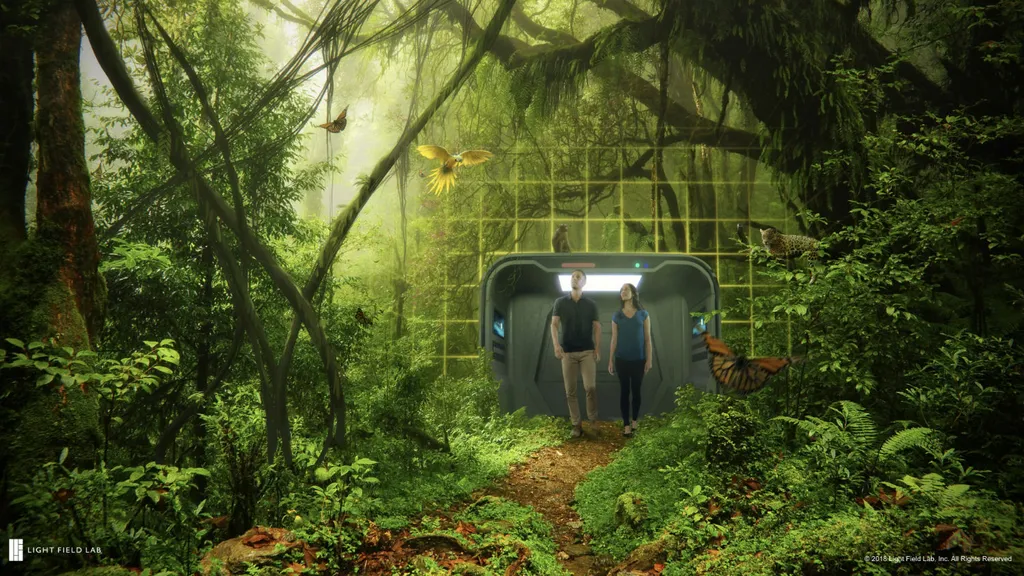Los Angeles-based rendering company OTOY is teaming up with startup Light Field Lab to build a pipeline for holographic content creation and display.
Light Field Lab raised $7 million earlier this year to complete a prototype of its display technology which is meant to fulfill a few key features of Star Trek’s holodeck. Namely, Light Field Lab’s technology could theoretically be equipped along the walls of a room to show multiple people optically correct virtual worlds without any specialized eyewear. According to Light Field Lab CEO Jon Karafin they’ve been demonstrating prototypes to “key industry leaders throughout the year.”
“No headgear, no head-tracking, no vergence/accommodation conflict, no motion latency, no headaches or eye strain, nor other artifacts associated with other non-holographic technologies,” Karafin wrote in an email. “The panels are flat panel, solid state and directly emissive— meaning there are no moving parts or arrays of projectors or cumbersome accessories. When you see the holographic objects with the prototype system, your eye naturally focuses on the actual object in space, and your brain tells you it’s floating right there in front of you — because it is a dense holographic projection with converging ray bundles that form real images. The current prototype represents the foundational building block that produces large format panels, walls, and surfaces as we head into manufacturing next year.”
Realizing Star Trek’s holodeck is also the goal of OTOY’s founder Jules Urbach, whose technology is used by creatives to render photo-realistic visuals for various purposes, like the haunting opening sequence of Westworld.
Urbach’s work crosses into a lot of different areas and he’s also the driving force behind RNDR — a blockchain-based token built around the idea of distributing rendering tasks to unused graphics processing units around the world.
The partnership between Light Field Lab and OTOY aims to combine all these technologies to supply the visuals emerging from Light Field Lab displays. We haven’t seen Light Field Lab’s technology yet but I’ve spent a fair amount of time with Urbach and he believes they’ve had a breakthrough:
When you wrote that article, I knew this was where we wanted to be a year out. I was waiting for the Light Field Lab prototypes and to see them with my own eyes, running our content, before being certain this was going to work. We also very much need the scale that RNDR provides for this pipeline to be feasible (both for pre-computing LF data and composing and streaming LF media to the display).
The principle behind the Light Field Lab displays is something that many have considered over the years as a path to holographic panels – but getting 1000’s of DPI and the optics/mechanics of bending rays without showing tiling is mechanically very difficult and so daunting (especially in full color, and full motion) that few thought it might be possible even in prototype form today. I have tested enough of our stack on the 6×4 inch prototype to see that LFL has solved the hardest problems needed to make this work – tiling is one of these issues. If you can tile the displays like LED walls, there is no limit to how big or what configuration that can be, hence the holodeck is viable.
According to Karafin, Light Field Lab partnered with OTOY because Urbach “is one of the most brilliant people I have ever worked with, and we have a shared vision to enable the Holodeck together. OTOY has industry-leading physics-based GPU rendering technologies that are already integrated into most of the content creation tools that enable content creators to produce holographic objects extremely efficiently. We will start with smaller scale installations with these holographic objects, characters and experiences to mature the technology and ecosystem with the ultimate goal of enabling the Star Trek Holodeck.”
Content to be shown on these new displays is in active development by Rod Roddenberry (Executive Producer on Star Trek: Discovery and son of Star Trek creator Gene Roddenberry) as well from OTOY investor Ari Emanuel, who is also the CEO of Endeavor (one of Hollywood’s most influential talent companies).
“OTOY has created the capture, rendering and streaming technology for the industry to transition to holographic content development, as well as the RNDR blockchain for IP rights and distribution,” Emanuel said in a prepared statement. “We’re excited to use this platform to bring true holographic content to Light Field Lab’s displays, which will give consumers unbelievable experiences, without the burden of 3D glasses or VR headsets.”
The featured image at the top of this post is captioned “future vision concept art of room scale holographic display from Light Field Lab.”


























